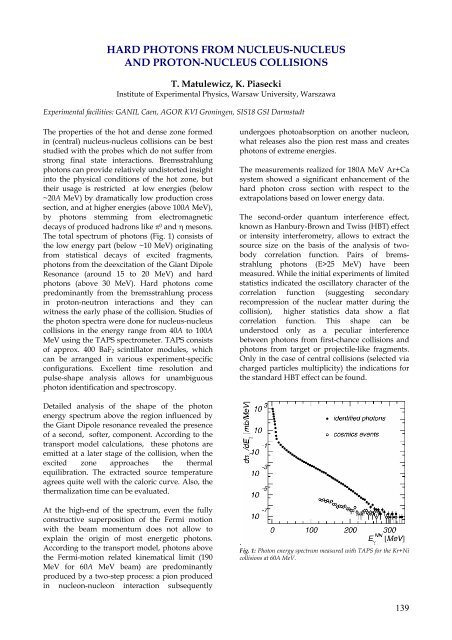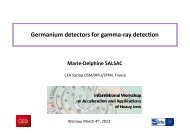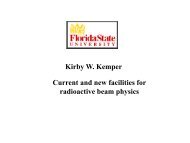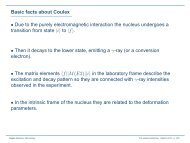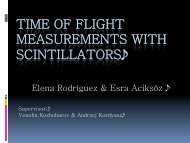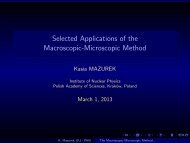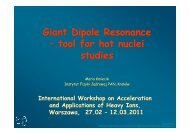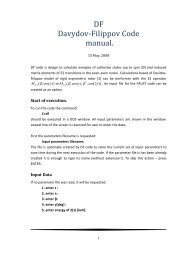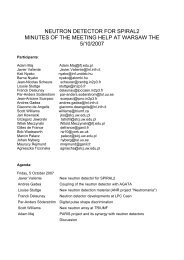[1] T. Barczyk, J.Brzychczyk, P. Burzyński, W. Gawilikowicz, K.Grotowski, S.Micek, P. Pawłowski,R. Płaneta, A.J.Cole, A.Chabane, P.Desesquelles, A.Giorni, D.Heuer, A.Lleres, J.B.Viano,D.Benchekroun, B.Cheynis, A.Demeyer, E.Gerlic, D.Gu<strong>in</strong>et, P.Lautesse, L.Lebreton, E.Bisquer, M.Stern,L.Vagneron. M.Charvet, Nucl. Instr. Meth. A364, 311 (1995).[2] Z. Sos<strong>in</strong>, K. Grotowski, A. Wieloch and H.W. Wilschut, Acta Phys. Pol. B 25 (1994).[3] P. Pawłowski, J. Brzychczyk, P. Burzyński, D. Benchekroun, A. Chabane, M. Charvet, B. Cheynis,A.J. Cole, A. Demeyer, P. Desesquelles, W. Gawlikowicz, E. Gerlic, A. Giorni, K. Grotowski, D. Gu<strong>in</strong>et,D. Heuer, P. Lautesse, L. Lebreton, A. Lleres, S. Micek, R. Płaneta, Z. Sos<strong>in</strong>, M. Stern, L. Vagneron,J.B. Viano, A. Wieloch, Phys.Rev. C54, R10 (<strong>1996</strong>).[4] P.Pawłowski, D.Benchekroun, J.Brzychczyk, A.Chabane, M.Charvet, B.Cheynis, A.J.Cole, A.Demeyer,P.Desesquelles, W.Gawlikowicz, E.Gerlic, A.Giorni, K.Grotowski, D.Gu<strong>in</strong>et, D.Heuer, P.Lautesse,L.Lebreton, A.Lleres, S.Micek, R.Płaneta, Z.Sos<strong>in</strong>, M.Stern, L.Vagneron, J.B.Viano, A.Wieloch,Z.Phys. A357, 387 (1997).[5] P.Pawłowski, J.Brzychczyk, A.J.Cole, P.Desesquelles, W.Gawlikowicz, K.Grotowski, P.Hachaj,S.Micek, R.Płaneta, Z.Sos<strong>in</strong>, A.Wieloch, D.Benchekroun, E.Bisquer, A.Chabane, M.Charvet, B.Cheynis,A.Demeyer, E.Gerlic, A.Giorni, D.Gu<strong>in</strong>et, D.Heuer, P.Lautesse, L.Lebreton, A.Lleres, M.Stern,L.Vagneron, J.B.Viano, Phys.Rev. C57, 1771 (1998).[6] P.S. Hachaj, J.Brzychczyk, A.J.Cole, P.Desesquelles, W.Gawlikowicz, K.Grotowski, S.Micek,P.Pawłowski, Z.Sos<strong>in</strong>, A.Wieloch, D.Benchekroun, E.Bisquer, A.Chabane, M.Charvet, B.Cheynis,A.Demeyer, E.Gerlic, A.Giorni, D.Gu<strong>in</strong>et, D.Heuer, P.Lautesse, L.Lebreton, A.Lleres, M.Stern,L.Vagneron, J.B.Viano, Acta Phys. Pol. B29, 369 (1998).[7] R.Płaneta, W.Gawlikowicz, K.Grotowski, J.Brzychczyk, T.Ciszek, A.J.Cole,P.Desesquelles, S.Micek,P.Pawłowski, Z.Sos<strong>in</strong>, D.Benchekroun, A.Wieloch, E.Bisquer, A.Chabane, E.Gerlic, A.Giorni, D.Gu<strong>in</strong>et,D.Heuer, L. Lebreton, A.Lleres, M.Stern, L.Vagneron, J.B.Viano, Acta Phys. Pol. B31, 1479 (2000).[8] R.Płaneta, W. Gawlikowicz, A. Wieloch, J. Brzychczyk, T.Ciszek, A.J. Cole, P. Desesquelles,K. Grotowski, P. Hachaj, S. Micek, P. Pawłowski, Z. Sos<strong>in</strong>, D. Benchekroun, E. Bisquer, A. Chabane,M.Charvet, B. Cheynis, A. Demeyer, E. Gerlic, A. Giorni, D. Heuer, P. Lautesse, L. Lebreton,A. Lleres, M. Stern, L. Vagneron, and J.B. Viano, European Physical Jounal A11, 297 (2001).[9] Z. Sos<strong>in</strong>, R. Płaneta, T. Ciszek, J. Brzychczyk, W. Gawlikowicz, K. Grotowski, S. Micek,P. Pawłowski, A. Wieloch, A.J. Cole, D. Benchekroun, E. Bisquer, A. Chabane, M. Charvet,B. Cheynis, A. Demeyer, P. Desesquelles, E. Gerlic, A. Giorni, D. Heuer, P.Lautesse, L. Lebreton,A. Lleres, M. Stern, L. Vagneron, and J.B. Viano European Physical Jounal A11, 305 (2001).[10] Z. Sos<strong>in</strong>, European Physical Jounal A11, 311 (2001).[11] R.Płaneta, Z. Sos<strong>in</strong>, T. Ciszek, P. Hachaj, W.Gawlikowicz, K.Grotowski, S.Micek, P.Pawłowski,A.J.Cole, P.Desesquelles, D.Benchekroun, A.Wieloch, E.Bisquer, A.Chabane, E.Gerlic, A.Giorni,D.Gu<strong>in</strong>et, D.Heuer, L. Lebreton, A.Lleres, M.Stern, L.Vagneron, J.B.Viano, Acta Phys. Pol. B32, 3079(2001).[12] W.Gawlikowicz, R.Płaneta, K. Grotowski, J. Brzychczyk, P. Hachaj, S. Micek, P. Pawłowski,Z. Sos<strong>in</strong>, A. Wieloch, P. Desesquelles, A.J. Chabane, M.Charvet, A. Giorni, D. Heuer, A. Lleres,J.B. Viano, D. Benchekroun, E. Bisquer, B.Cheynis, A. Demeyer, E. Gerlic, D. Gu<strong>in</strong>et, P. Lautesse,L. Lebreton, M. Stern, L. Vagneron, Nuclear Physics A681, 295 (2001)[13] Z. Sos<strong>in</strong>, Acta Physica Polonica B37, 2859 (<strong>2006</strong>).[14] R. Płaneta, Int. J. of Mod. Phys. E15, 937 (<strong>2006</strong>).138
HARD PHOTONS FROM NUCLEUS-NUCLEUSAND PROTON-NUCLEUS COLLISIONST. Matulewicz, K. PiaseckiInstitute of Experimental Physics, Warsaw University, WarszawaExperimental facilities: GANIL Caen, AGOR KVI Gron<strong>in</strong>gen, SIS18 GSI DarmstadtThe properties of the hot and dense zone formed<strong>in</strong> (central) nucleus-nucleus collisions can be beststudied with the probes which do not suffer fromstrong f<strong>in</strong>al state <strong>in</strong>teractions. Bremsstrahlungphotons can provide relatively undistorted <strong>in</strong>sight<strong>in</strong>to the physical conditions of the hot zone, buttheir usage is restricted at low energies (below~20A MeV) by dramatically low production crosssection, and at higher energies (above 100A MeV),by photons stemm<strong>in</strong>g from electromagneticdecays of produced hadrons like π 0 and η mesons.The total spectrum of photons (Fig. 1) consists ofthe low energy part (below ~10 MeV) orig<strong>in</strong>at<strong>in</strong>gfrom statistical decays of excited fragments,photons from the deexcitation of the Giant DipoleResonance (around 15 to 20 MeV) and hardphotons (above 30 MeV). Hard photons comepredom<strong>in</strong>antly from the bremsstrahlung process<strong>in</strong> proton-neutron <strong>in</strong>teractions and they canwitness the early phase of the collision. Studies ofthe photon spectra were done for nucleus-nucleuscollisions <strong>in</strong> the energy range from 40A to 100AMeV us<strong>in</strong>g the TAPS spectrometer. TAPS consistsof approx. 400 BaF 2 sc<strong>in</strong>tillator modules, whichcan be arranged <strong>in</strong> various experiment-specificconfigurations. Excellent time resolution andpulse-shape analysis allows for unambiguousphoton identification and spectroscopy.undergoes photoabsorption on another nucleon,what releases also the pion rest mass and createsphotons of extreme energies.The measurements realized for 180A MeV Ar+Casystem showed a significant enhancement of thehard photon cross section with respect to theextrapolations based on lower energy data.The second-order quantum <strong>in</strong>terference effect,known as Hanbury-Brown and Twiss (HBT) effector <strong>in</strong>tensity <strong>in</strong>terferometry, allows to extract thesource size on the basis of the analysis of twobodycorrelation function. Pairs of bremsstrahlungphotons (E>25 MeV) have beenmeasured. While the <strong>in</strong>itial experiments of limitedstatistics <strong>in</strong>dicated the oscillatory character of thecorrelation function (suggest<strong>in</strong>g secondaryrecompression of the <strong>nuclear</strong> matter dur<strong>in</strong>g thecollision), higher statistics data show a flatcorrelation function. This shape can beunderstood only as a peculiar <strong>in</strong>terferencebetween photons from first-chance collisions andphotons from target or projectile-like fragments.Only <strong>in</strong> the case of central collisions (selected viacharged particles multiplicity) the <strong>in</strong>dications forthe standard HBT effect can be found.Detailed analysis of the shape of the photonenergy spectrum above the region <strong>in</strong>fluenced bythe Giant Dipole resonance revealed the presenceof a second, softer, component. Accord<strong>in</strong>g to thetransport model calculations, these photons areemitted at a later stage of the collision, when theexcited zone approaches the thermalequilibration. The extracted source temperatureagrees quite well with the caloric curve. Also, thethermalization time can be evaluated.At the high-end of the spectrum, even the fullyconstructive superposition of the Fermi motionwith the beam momentum does not allow toexpla<strong>in</strong> the orig<strong>in</strong> of most energetic photons.Accord<strong>in</strong>g to the transport model, photons abovethe Fermi-motion related k<strong>in</strong>ematical limit (190MeV for 60A MeV beam) are predom<strong>in</strong>antlyproduced by a two-step process: a pion produced<strong>in</strong> nucleon-nucleon <strong>in</strong>teraction subsequently.Fig. 1: Photon energy spectrum measured with TAPS for the Kr+Nicollisions at 60A MeV.139
- Page 3:
NUCLEAR PHYSICSIN POLAND1996-20063
- Page 6 and 7:
Report of Polish Nuclear Physics Ne
- Page 8 and 9:
4• The isoscalar bosons in nuclea
- Page 10 and 11:
6• Application of the Mössbauer
- Page 13 and 14:
POLISH NUCLEAR PHYSICS NETWORKJerzy
- Page 15 and 16:
Fig. 4. AIC-144, K=60 light particl
- Page 17:
OVERVIEW PAPERS13
- Page 20 and 21:
A successfulstudy on the decay ofpr
- Page 22 and 23:
visible light and a CCD camera will
- Page 24 and 25:
the heavy ion cyclotron up to an en
- Page 26 and 27:
investigated by means of ALICE and
- Page 28 and 29:
and/or baryon density of the nuclea
- Page 30 and 31:
Figure 5. Top: K - /K + ratio in Ni
- Page 32 and 33:
Acknowledgements: I would like to t
- Page 34 and 35:
7%6%5%4%3%2%1%0%8%7%6%5%4%3%2%1%0%E
- Page 37 and 38:
NUCLEAR PHYSICS IN POLAND - APPLICA
- Page 39 and 40:
Funds of the European Union foresee
- Page 41 and 42:
POSSIBLE LOCATION FOR THE UNDERGROU
- Page 43 and 44:
Fig. 5. Time dependence of maximume
- Page 45:
CONTRIBUTIONS41
- Page 48 and 49:
[1] K. Pomorski, B. Nerlo-Pomorska,
- Page 50 and 51:
[1] K. Pomorski and J. Dudek, Phys.
- Page 52 and 53:
[1] J. Jastrzębski, H. Daniel, T.
- Page 54 and 55:
[1] P.Adrich, A.Klimkiewicz, M. Fal
- Page 56 and 57:
[4] J. Dobaczewski, W. Nazarewicz,
- Page 58 and 59:
[1] A. Sobiczewski, F.A. Gareev, B.
- Page 60 and 61:
[1] R. Smolańczuk, Phys. Rev. C 56
- Page 62 and 63:
[1] W.J. Świątecki, K. Siwek-Wilc
- Page 64 and 65:
[1] J. Peter, N. Alamanos, N. Amar,
- Page 66 and 67:
[1] R. Broda, J. Phys. (London) G32
- Page 68 and 69:
1. J. Styczeń, J. Chevallier, B. H
- Page 70 and 71:
[1] E. Grodner, J. Srebrny, Ch. Dro
- Page 72 and 73:
[1] C.Plettner, L.Batist, J.Doring,
- Page 74 and 75:
[1] W. Kurcewicz, Hyperfine Interac
- Page 76 and 77:
[1] M. Sugawara, Y. Toh, T.Czosnyka
- Page 78 and 79:
[1] M.Loewe, J.de Boer, H.J.Maier,
- Page 80 and 81:
[1] S.G. Rohoziński, K. Starosta,
- Page 82 and 83:
[1] B. Nerlo-Pomorska, K. Pomorski,
- Page 84 and 85:
[1] L.Próchniak, K.Zając, K.Pomor
- Page 86 and 87:
[1] J. Dobaczewski, J. Dudek, Comp.
- Page 88 and 89:
[1] W. Nazarewicz, J. Dobaczewski,
- Page 90 and 91:
[1] L. Próchniak, P. Quentin, D. S
- Page 92 and 93: [1] K. Zając, Acta Phys. Pol. B34,
- Page 94 and 95: [1] L. Próchniak, K. Zając, K. Po
- Page 96 and 97: [1] A.Maj, M.Kmiecik, F.Camera, B.H
- Page 98 and 99: [1] M.Kicińska-Habior, K.A.Snover,
- Page 100 and 101: [1] P.Adrich, A.Klimkiewicz, M. Fal
- Page 102 and 103: [1] K. Czerski, H. Bucka, P. Heide
- Page 104 and 105: [1] C.R Bingham, M.N. Tantawy, J.C.
- Page 107 and 108: NUCLEAR OPEN QUANTUM SYSTEM MANY-BO
- Page 109 and 110: THREE-NUCLEON FORCE EFFECTS IN NUCL
- Page 111 and 112: RELATIVISTIC EFFECTS IN THREE-NUCLE
- Page 113 and 114: ELECTRON AND PHOTON SCATTERING ON T
- Page 115 and 116: EXPERIMENTAL STUDIES OF THREE-NUCLE
- Page 117 and 118: A SEARCH FOR MAJORANA NEUTRINOExper
- Page 119 and 120: DOUBLE BETA DECAY MATRIX ELEMENTS I
- Page 121 and 122: NEUTRINOLESS DOUBLE BETA DECAYIN SU
- Page 123 and 124: FUSION BARRIER DISTRIBUTIONSP.Czosn
- Page 125 and 126: NUCLEAR OPTICAL POTENTIAL FROM LIGH
- Page 127 and 128: REACTIONS WITH LOOSELY BOUND PROJEC
- Page 129 and 130: NEUTRON-INDUCED REACTIONSJ. Andrzej
- Page 131 and 132: NUCLEAR FUSION AND FISSION IN MEAN-
- Page 133 and 134: FISSION AND FUSION OF NUCLEI WITHIN
- Page 135 and 136: ENHANCED ELECTRON SCREENING IN DEUT
- Page 137 and 138: EXPERIMENTAL APPROACHES TO HEAVY IO
- Page 139 and 140: HEAVY ION EXPERIMENTS AT LNS CATANI
- Page 141: HEAVY ION REACTION MECHANISMS AT FE
- Page 145 and 146: NEUTRAL MESON PRODUCTION AND BARYON
- Page 147 and 148: CORRELATIONS AND FLUCTUATIONS IN HE
- Page 149 and 150: MASS AND ISOTOPIC EFFECTS IN NUCLEA
- Page 151 and 152: NUCLEAR MATTER AT THE LIQUID-GAS PH
- Page 153 and 154: HEAVY-ION COLLISIONS: GEOMETRY AND
- Page 155 and 156: MULTIFRAGMENTATION IN HEAVY-ION COL
- Page 157 and 158: ULTRA-RELATIVISTIC REACTIONS BETWEE
- Page 159 and 160: INVESTIGATION OF HADRON PROPERTIES
- Page 161 and 162: SPALLATION AND FRAGMENTATION OF ATO
- Page 163 and 164: STRANGE-PARTICLE PRODUCTION IN NUCL
- Page 165 and 166: PHASE TRANSITIONS IN HIGHLY EXCITED
- Page 167 and 168: NUCLEAR SINGLE PARTICLE SUM RULES I
- Page 169 and 170: FLUCTUATIONS AND SEARCH FOR THE CRI
- Page 171 and 172: BETWEEN NUCLEAR AND ELEMENTARY INTE
- Page 173 and 174: INVESTIGATION OF CHARGE AND ISOSPIN
- Page 175 and 176: NUCLEAR STATES OF η, K MESONS, Σ
- Page 177 and 178: HYPERON RESONANCES PRODUCED IN PROT
- Page 179 and 180: NONMESONIC DECAY OF Λ - HYPERON IN
- Page 181 and 182: INTERACTION OF THE η AND η΄ MESO
- Page 183 and 184: INVESTIGATION OF THE HYPERON-NUCLEO
- Page 185 and 186: η AND η΄ MESONS PRODUCTION IN D-
- Page 187 and 188: K+ PRODUCTION IN PROTON-NUCLEUS REA
- Page 189 and 190: INTERACTION OF K + K - MESONSJ. Bal
- Page 191 and 192: PRODUCTION OF K+ AND K- MESONS IN H
- Page 193 and 194:
AT THE BORDER BETWEEN ATOMIC AND NU
- Page 195 and 196:
ATOMIC PHYSICS IN HEAVY ION - ATOM
- Page 197 and 198:
PRECISION TESTS OF THE STANDARD MOD
- Page 199 and 200:
SEARCH FOR TIME REVERSAL VIOLATION
- Page 201 and 202:
HIGH INTENSITY ULTRA-COLD NEUTRON S
- Page 203 and 204:
NUCLEAR PHYSICS WITH ULTRACOLD ATOM
- Page 205 and 206:
FORWARD SPECTROMETER FOR PANDAD. Gi
- Page 207 and 208:
DESIGN STUDIES OF CHARMONIUM DETECT
- Page 209 and 210:
ONLINE EVENT SELECTION IN THE CBM E
- Page 211 and 212:
DEVELOPMENT OF A FAST DATA READOUT
- Page 213 and 214:
NEW TECHNOLOGIES OF SILICON DETECTO
- Page 215 and 216:
NUCLEAR REACTIONS IN THE ACCELERATI
- Page 217 and 218:
NATURAL RADIOACTIVITY STUDIES IN SO
- Page 219 and 220:
APPLICATION OF THE MÖSSBAUER SPECT
- Page 221 and 222:
POSITRON ANNIHILATION LIFETIME SPEC
- Page 223 and 224:
VALIDATION OF NUCLEAR DATA AND MODE
- Page 225 and 226:
LOOK TO THE FUTURE: NUCLEARPHYSICS
- Page 227 and 228:
LONG-RANGE PLAN OF POLISH NUCLEAR P
- Page 229 and 230:
225
- Page 231 and 232:
THE OUTLINE OF BUDGET EXPENDITUREST
- Page 233 and 234:
INSTITUTION AND AUTHORINDEXES229
- Page 235 and 236:
INSTITUTION INDEXAA. Sołtan Instit
- Page 237 and 238:
Kistryn, S, 111, 157, 169, 193, 195
- Page 239 and 240:
UNITS OF POLISH NUCLEAR PHYSICSNETW
- Page 241 and 242:
POLISH NUCLEAR PHYSICS NETWORKList
- Page 243 and 244:
LIST OF ELECTRONIC ADDRESSES239
- Page 245 and 246:
Nuclear Physics community in Poland
- Page 247 and 248:
Faculty of Physics and Applied Info
- Page 249 and 250:
Kurpeta Jan jkurpeta@mimuw.edu.plMa
- Page 251 and 252:
Gil Damian damian.gil@if.uj.edu.plG
- Page 253 and 254:
Nuclear Physics community in Poland
- Page 255 and 256:
Kopeć Mariusz AGH FPACS mariusz@no
- Page 257 and 258:
Rząca-Urban Teresa IEP UW rzaca@@f
- Page 259 and 260:
Białkowska Helena IPJ Helena.Bialk
- Page 261 and 262:
Krauze Maciej IP US meszik@nuph.us.
- Page 263 and 264:
Słowiński Bronisław PhF WUT slow
- Page 265 and 266:
AGH FPACS - AGH University of Scien


